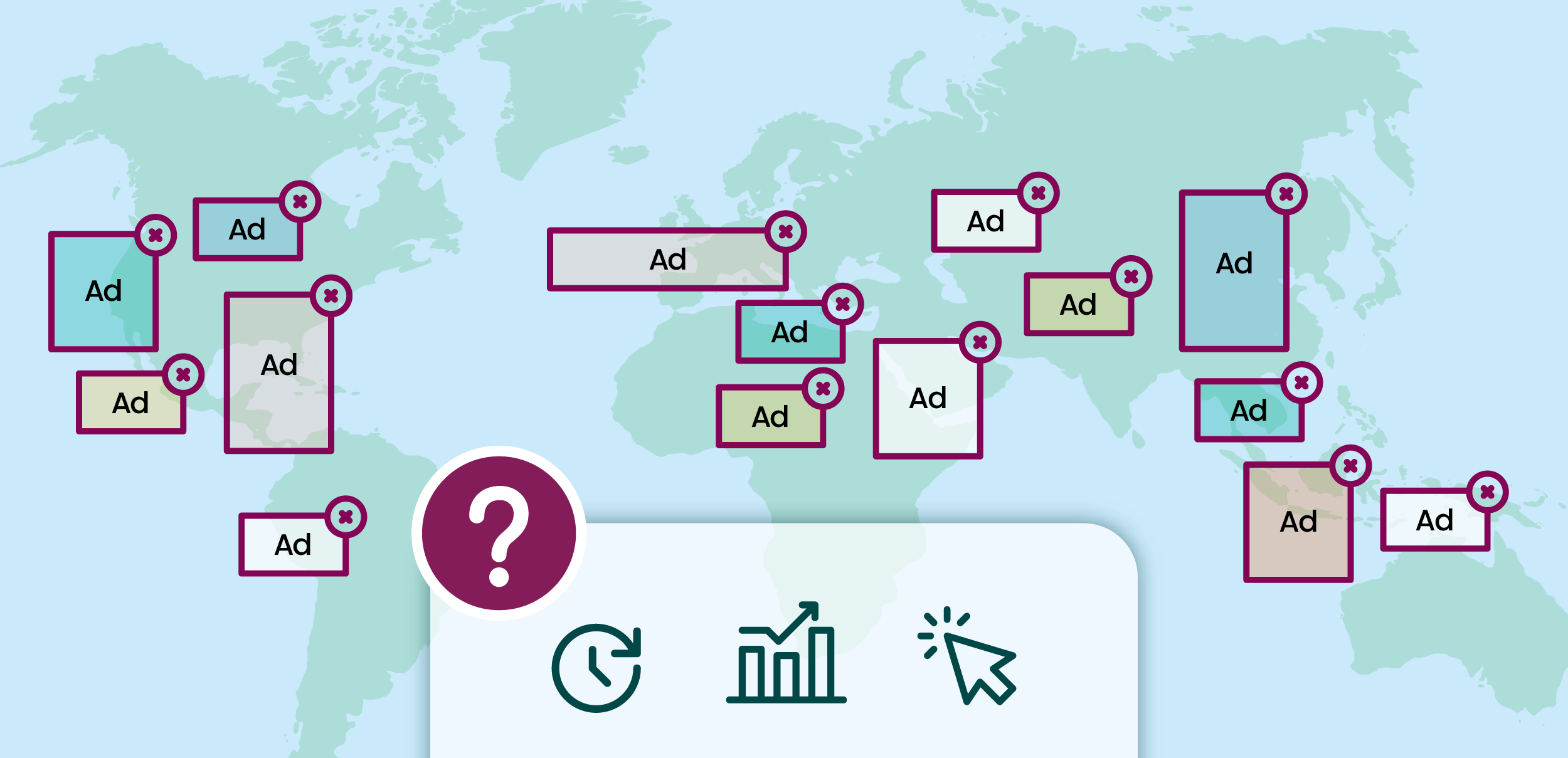How you should deal with ad blockers- the most recent industry headache
By Asaf Shamly | January 28, 2021

You could say that Ad Blockers have proven to be a real pain for publishers – but that would be an understatement. Whilst this browser add-on has given standard internet users the opportunity to scour the web without being ambushed by a horde of pop-up screens, publishers have been left with a significant chunk of users that will not see their advertising. With over 200 MILLION people around the world now using Ad Blockers, the estimated loss of global revenue due to blocked advertising during 2015 was $21.8B. (PageFair and Adobe 2015 Ad Blocking Report)
Therefore, publishers need to address the issue of Ad Blockers by approaching advertising in a totally different way, starting with paying attention to users’ privacy and experience. Effective advertisements aren’t about bombardment and intrusion – they’re about delivering relevant ads to the right people, in the right way, in the right places and at the right time.
In this post I would like to offer you, the publishers, several possible approaches to dealing with and overcoming the challenges presented by Ad Blockers.
The Rise of Ad Blockers
One of the key reasons behind the rise in popularity of Ad Blockers is that they make users feel safe and in control, regarding the content and advertisements they are exposed to. Intrusive ads and pop-ups have a reputation for being loaded with malware, spyware and other viruses that can damage computers and/or steal data. It eventually reached a point where a pop-up represented danger: If a colorful ad with music suddenly appeared on the page, it was time to get out of there. Looking back, it’s hardly surprising that Ad Blockers were created, and even less surprising that these add-ons were fully embraced by Internet users.
So, what can publishers do to get around Ad Blockers?
Focus on Relevancy
The problem with a lot of online ads is that they’re completely irrelevant to the person who sees them. For example, if a user is browsing a sports site and is met with an influx of beauty product ads, chances are they’ll simply be irritated by these adverts rather than feel inclined to click on them. Irrelevant ads create a sense of distrust towards advertisers and publishers, who are responsible for delivering the content.
By focusing on a relevant audience rather than forcing adverts down every individual user’s throat, you can attract a crowd who are genuinely interested in the product you’re selling.
Today’s Ad Exchanges took upon them to work towards increased ad relevancy so advertisers can better reach their target audience.
Ad Exchanges, a marketplace that enables advertisers and publishers to buy and sell inventory in real time and provide better targeting, serve the right ad to the right user in the right screen at the right time. Popular Ad Exchanges include: DoubleClick, OpenX, AppNexus, PubMatic and more.
Try to match the format with the audience, drive more relevance and intimacy across all of your marketing and always personalize your marketing and adverts. Use simple, clear language about what you’re advertising, and, while it’s OK to stay colorful, don’t go jazzing things up too much so that the content appears overbearing.
Consider Ad Delivery
Strategic placement of ads is key – especially on mobile when users can’t always select things easily by just tapping. Put some time into creating ads that are of an appropriate size for mobile users (as well as desktop users) – not so big so that it’s overwhelming, but not so small that they are hard or impossible to click on. While CTAs (call to action) can be tactically placed in various spots on a desktop web page, it is often wise to stick them high up on the mobile page version of the site.
Always use compatible technologies for both mobile and desktop, such as HTML5 or JQuery. They won’t require any additional plugins and can ensure ads remain easily clickable.
A/B testing is also an important component in your ad delivery process, the method of comparing two versions of ads, web page or app is very effective in order to determine which one performs better. Use A/B testing tools in your daily advertising routine, while many tools are available it’s crucial to choose the one that answers your needs, you can start your research with companies such as: Optimizely, Unbounce and Kissmetrics and see what do they have to offer.
It’s also worth using new monetization technologies such as Browsi’s engine, which scans multiple page elements (length, number of paragraphs, images and videos) in real-time, as every page loads, in order to detect new potential ad placements which can lead to new revenue without damaging the user experience.
Create a Positive User Experience
The user experience of an ad is one of the key factors in determining whether they will engage with it or not. Online advertising can drive your users away on mobile. If an ad does not load in less than five seconds, the user will tend to get frustrated, and close it as soon as they possibly can. Invest time in generating ad content that will load quickly on mobile. By using ad servers for better serving your ads you can prevent discomfort for your users. There are various ad servers out there for you to choose from for mobile and display, such as: DFP, Adtech and MoPub.
Also, it’s important to plan where you place in-ad buttons. Users detest fake “X”/Close page buttons that open advertisements, and will rarely if ever engage with them. Users don’t like feeling mislead, and if you’re placing a hyperlink in your content, make sure to take the user somewhere relevant and valuable, not only to an advert. You need to gain your user’s trust. It is up to you as the publisher to create adverts that appear trustworthy, interesting and relevant
Generally, never interrupt someone’s user experience, keep pop-ups to a minimum and don’t use pop-under because as it tells users that their needs aren’t that important to you. If you don’t pay attention to this, you may lose them forever.
Summary
Getting around and overcoming the obstacles Ad Blockers create, require you to have the consumer on your side. Everyone claims to dislike adverts, but if you offer your users something they actually need and want without forcing it upon them, they’ll be far more likely to engage with your ads and actually click through and make a purchase (and generate some $$ for you, the publisher). By creating ads that are relevant, that are delivered in an effective way, and that offer a positive user experience, you’re on the right path to convince users to forgo Ad Blockers.
Latest Articles
-

We Now Know What Ad Was Served. We Still Don’t Know if it Mattered.
The IAB’s new ACIF standard brings much-needed structure to creative asset tracking in programmatic advertising. It’s a meaningful step — but knowing what was served isn’t the same as knowing if it mattered. This piece explores what ACIF fixes, what it doesn’t, and why understanding the experience of an ad is key to measuring true impact.
View Now -

When Budgets Shrink, Transparency Becomes Power
Today’s media teams aren’t just asked to drive results; they’re asked to defend them. In a market where ad budgets are under the microscope and every dollar must prove its worth, clarity and efficiency win. It’s no longer about spending more — it’s about spending smarter. The brands that can surface waste, double down on what works, and adapt in real time will be the ones that thrive in this new media economy.
View Now -

In Real-Estate and in AdTech – Location is (Almost) Everything
You can have the best ad in the world - high-performing creative, long time in view, shown to an engaged user. But if it’s squeezed between seven other ads on a cluttered page? It’s not going to land. That’s the part we don’t talk about enough. The environment. The layout. The density. The visual noise around the impression. Let’s talk about two under appreciated KPIs that shape that environment.
View Now
